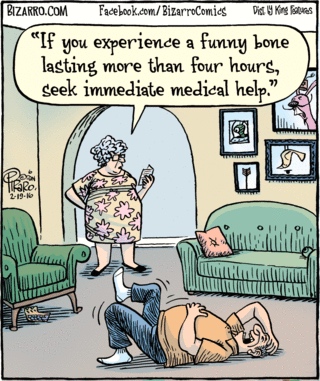This will turn into another News for Penises postings.
Today’s Bizarro shows a man in the throes of what we might call ulnarism:
(If you’re puzzled by the odd symbols in the cartoon — Dan Piraro says there are 6 in this strip — see this Page.)
Two pieces of stuff here.
First, the ambiguity of funny bone. From NOAD2:
[1] the part of the elbow over which the ulnar nerve passes. A knock on the funny bone may [by stimulating the ulnar nerve] cause numbness and pain [or just a strong twinge, a funny — that is, odd — feeling] along the forearm and hand.
[2] a person’s sense of humor, as located in an imaginary physical organ: photographs to jostle the mind and the funny bone.
The second sense (a play on words that hinges on two senses of funny) is the one in the cartoon.
Second, the text that the woman is reading from. This is based on one version of a warning customarily provided by the makers of the erection drugs Viagra, Cialis, and Levitra:
If you experience an erection lasting more than four hours, seek immediate medical help.
You should get help because you’re suffering from persistent erection, or priapism, a very dangerous (but treatable) condition, associated with blood pooling in the penis, that can be triggered by erection drugs.
And that takes us to Priapus. From Wikipedia:
In Greek mythology, Priapus … was a minor rustic fertility god, protector of livestock, fruit plants, gardens and male genitalia. Priapus is marked by his oversized, permanent erection, which gave rise to the medical term priapism. He became a popular figure in Roman erotic art and Latin literature, and is the subject of the often humorously obscene collection of verse called the Priapeia.
And then there’s St. Priapus Church, briefly covered in a 11/5/13 posting of mine. Members of the church worship the phallus and semen. I happen to belong to a much looser community of men devoted to similar practices, but at home or in informal gathering places.
